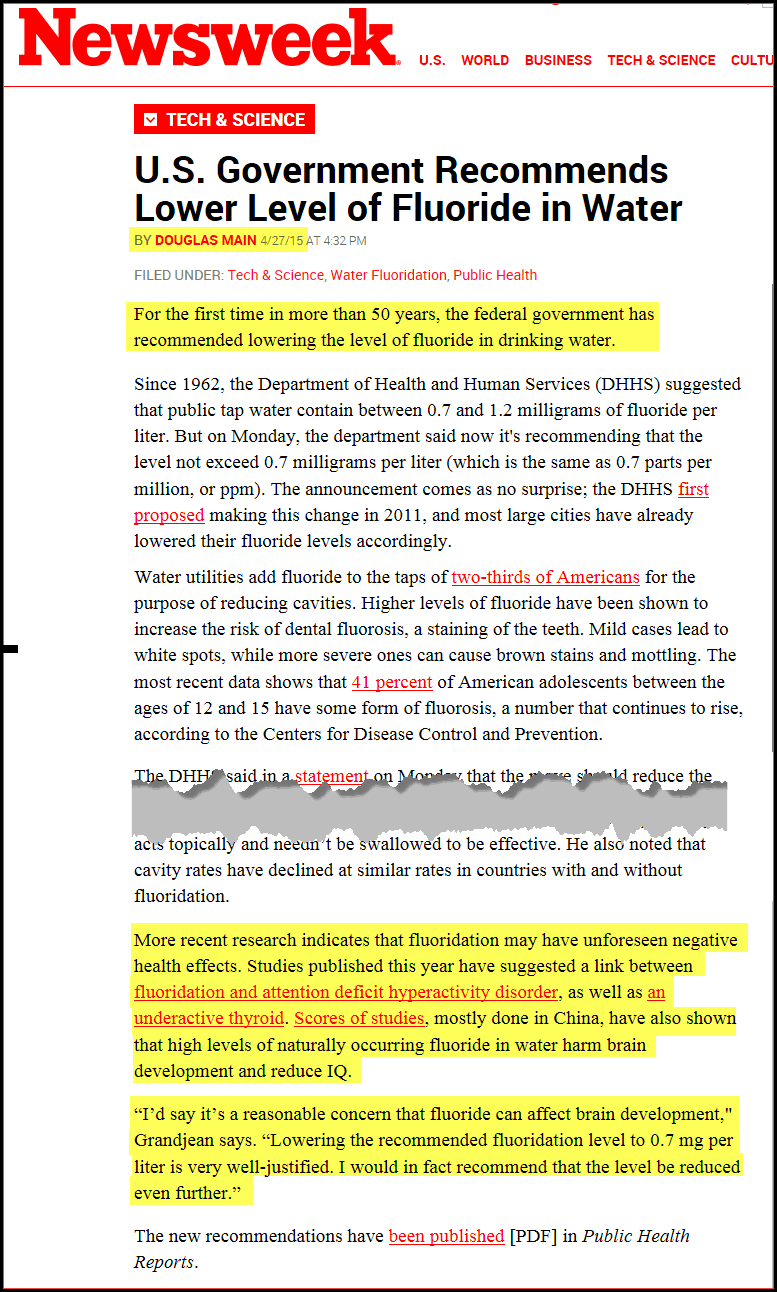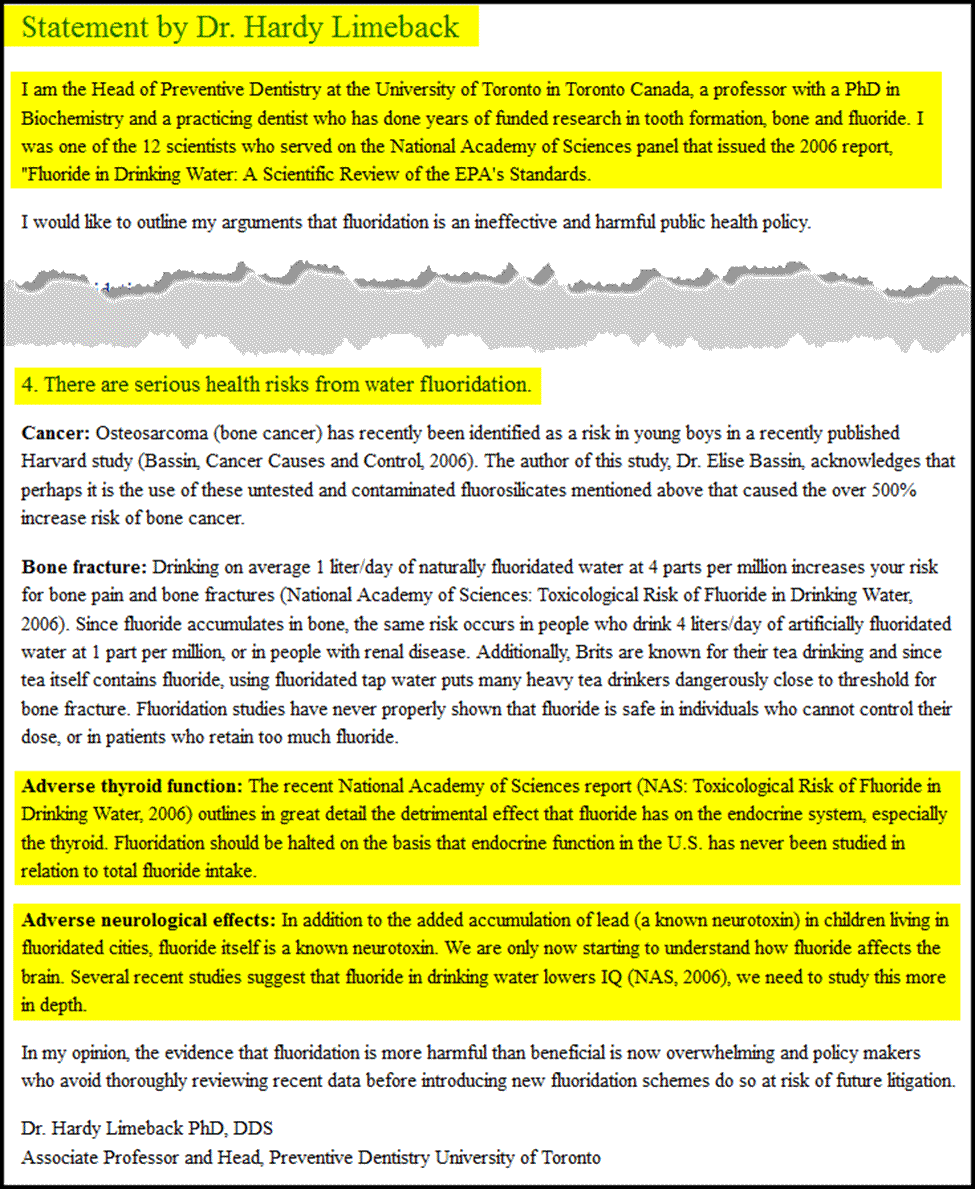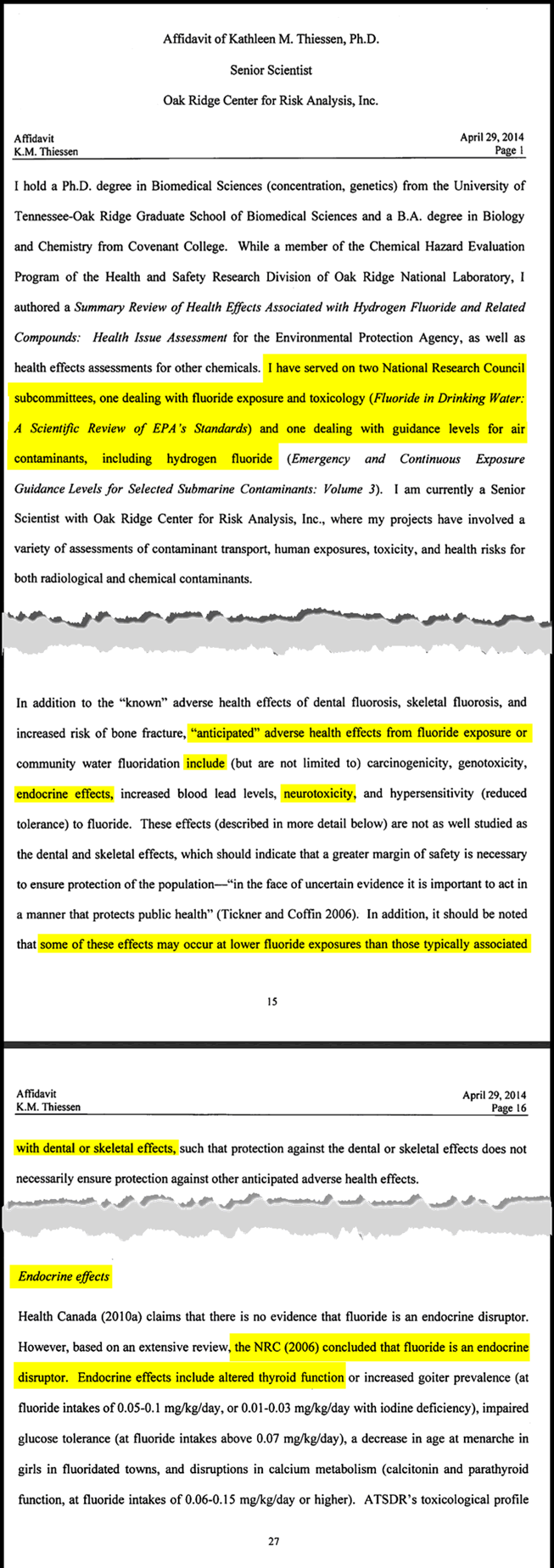
EARTH CLINIC EXCLUSIVE
April 21, 2015
Jason Uttley's revealing article, posted exclusively on Earth Clinic below, details mounting evidence of a connection between overexposure to fluoride and a host of related conditions, including: hypothyroidism, fibromyalgia & neurotoxicity.
Find out the disappointing truth about how the CDC turned a blind eye to public health by promoting a neurotoxin that has caused tens of millions of women to becoming sick with conditions related to chronic fluoride poisoning.
Why women in particular? Read the article to find out.
BREAKING NEWS
April 21, 2015
Erin Brockovich joins the fight to stop water fluoridation!
The famed consumer advocate who fought for safe drinking water for the citizens of Hinkley, California, and brought to light the health effects of hexavalent chromium from PG&E groundwater contamination, is now calling for an immediate end to fluoridation.
Brockovich calls the practice of dumping fluoride into the water supply “deplorable” in light of the latest information that has surfaced linking to fluoride ingestion to severe adverse health effects, including thyroid dysfunction and cognitive impairment.

April 27, 2015
Newsweek describes evidence linking fluoride to thyroid dysfunction and neurotoxicity.
On the day the Department of Health and Human Services (HHS) announced they were moving forward with their recommendation to lower the concentration of fluoride in drinking water, Douglas Main, of Newsweek, was one of the few journalists to point out that scientific evidence continues to mount linking fluoride to adverse thyroid function and brain damage.

See full article here: http://www.newsweek.com/us-government-recommends-lower-level-fluoride-water-325760
April 27, 2015
The U.S. Department of Health and Human Services lowers the official recommended concentration of fluoride in drinking water.
It’s safe to say that the former Secretary of the Department of Health and Human Services, Kathleen Sebelius, wasn’t entirely forthcoming when the proposal to reduce the amount of fluoride being dumped into municipal water supplies was made in 2011.
When the HHS referenced the 2006 National Research Council’s report on fluoride toxicity as the basis for the unprecedented change to the water fluoridation program, most of the public attention was placed on the adverse dental effects associated with fluoride.
However, authors of the NRC report, including Hardy Limeback & Kathleen Thiessen, have warned that the pitting and staining of teeth from excess fluoride consumption is really the least of their concerns. Both scientists believe that the water fluoridation program should be immediately terminated due to evidence linking fluoride to far more severe adverse health effects, including “adverse thyroid function” and “neurological effects.”

See full statement here: http://www.eidon.com/dr-hardy-limeback.html

See full statement here: http://fluoridealert.org/wp-content/uploads/peel.june2014.pdf
April 27, 2015
Erin Brockovich and the American Academy of Environmental Medicine warn the National Academy of Sciences and the Institute of Medicine that, unless they act promptly, they will be culpable for the continued harm caused by fluoride.
In a letter sent to the National Academy of Sciences (NAS), Institute of Medicine (IOM), and Food & Nutrition Board the same day as the government announcement lowering the recommended concentration of fluoride added to drinking water, Erin Brockovich, the American Academy of Environmental Medicine, Matthews & Associates of Houston, and others, lash out at the scientific community for continuing to base nutritional recommendations for fluoride on dated dental endorsements, rather than up-to-date science.
The notion that the Department of Health and Human Services is reducing fluoride levels in water solely because of adverse dental effects is disingenuous. The National Academy of Sciences should be reminded that they became involved in the issue after EPA scientists informed them that fluoride was a likely neurotoxin, linked to a range of conditions associated with cognitive impairment.
Since members of the National Academy of Sciences own Research Council now openly warn that this assessment is correct and fluoride is indeed a neurotoxin linked to specific medical conditions, the NAS has an obligation to inform the public of this fact, even if the Secretary of the Dept of Health and Human Services does not.
In the letter below, made available to Earth Clinic, Erin Brockovich and other signees warn National Academy of Sciences, Institute of Medicine, and Food & Nutrition Board, that they are accountable for informing the public about the adverse health effects of dietary fluoride within the context of their ’safe and adequate’ dietary intake recommendations.

Read the full letter here.
LIKE ISRAEL, U.S. SHOULD BAN FLUORIDE AMID HEALTH CONCERNS:
Thyroid Dysfunction, Fibromyalgia & Neurotoxicity Top List of Adverse Effects
By Jason Uttley
April 21, 2015
email: [email protected]
Nearly half a century after Minnesota passed legislation requiring the addition of fluoride to municipal water supplies, fluoride is under fire due to health concerns.[1] Evidence that the additive is not only a contributor to the epidemic of thyroid dysfunction, but also a likely neurotoxin linked to a range of conditions associated with cognitive impairment, has come as a shock, even to members of the scientific community who have reviewed the growing research.[2] On Aug. 26, 2014, faced with such disturbing evidence, Israel’s Health Minister Yael German ordered an end to the practice of water fluoridation.[3] While German has been criticized for her decisive action, the move comes as little surprise to the handful of experts in the U.S. who have been aware of the dangers associated with fluoride for years.
Reversing course on water fluoridation
Despite safety assurances from the American Dental Association (ADA) and Centers for Disease Control and Prevention (CDC), who have long advocated dumping fluoride into the water supply in the interest of dental health, new studies have made it hard to deny the evidence of long-term damage from fluoride ingestion.
Studies that showed lower IQ levels in children exposed to too much fluoride received little attention initially, even as additional research demonstrated a gradual build-up of fluoride in specific areas of the brain.[4] [5] [6] That changed when the Head of Neurotoxicology at the one of America’s most prestigious dental research facilities, the Harvard-affiliated Forsyth Institute, confirmed that cognitive impairment from fluoride appears very real indeed.[7]
By the time investigative journalist Christopher Bryson brought the story of neurotoxicologist Dr. Phyllis Mullenix into the public eye, with his 2004 book The Fluoride Deception, U.S. scientists had already uncovered similar studies that pointed to the same disturbing conclusion.[8] [9] The EPA confirmed that even at the so-called “optimal” level of 1 part per million — a concentration widely accepted for water fluoridation programs in most states — the cumulative effect of fluoride on humans is deleterious, at times resulting in brain and kidney damage.[10]
As with the majority of Americans, most officials failed to take the issue seriously at first due to decades of promotion that had convinced nearly everyone that fluoride had been proven safe to swallow. Massive marketing campaigns by the ADA, CDC and others equated fluoride opposition to quackery and conspiracy theories, which in-turn were messages reinforced by a media whose health stories have long been generated by a handful of journalists overly reliant on talking points provided by public health officials.
Those charged with reviewing the emerging evidence were among the first to realize that both the scientific community and general public had been profoundly misled regarding the safety of fluoride. As health officials slowly began to accept the evidence presented by their own scientists, they faced the daunting task of overcoming public perception, which their predecessors and colleagues had helped shape.
Ending fluoridation with no reason would inevitably trigger an avalanche of criticism not only from the dental community with a vested interest in maintaining the status quo, but from the media and public as well. On the other hand, completely revealing the full extent of scientific concerns might not only trigger widespread outrage, but a profound loss of trust in the institutions responsible. Health officials on opposite sides of the Atlantic decided to address this catch-22 scenario in very different ways.
Israel’s Health Minister German decided, in the fall of 2014, to be relatively forthcoming about some of the growing concerns when she implemented the recommendation of scientists by fully halting fluoridation. By contrast, U.S. Secretary of the Department of Health and Human Services Kathleen Sebelius decided, in the winter of 2011, on a much less transparent approach.
What the U.S. announcement failed to mention
In January of 2011, the U.S. Department of Health and Human Services (HHS) and the U.S. Environmental Protection Agency (EPA) made national headlines by issuing a joint recommendation to significantly lower the concentration of fluoride in water.[11] For Minnesota and some cold weather states, which maintain even higher levels in water, that proposal would cut the fluoride concentration by more than 40 percent, from 1.2 to 0.7 parts per million.
News of the Jan. 7, 2011, public announcement to draw down fluoride levels in the U.S. water supply was delivered to many by way of journalist, Mike Stobbe, whose articles on the subject appeared in newspapers across the United States, including both major newspapers in Minnesota.[12] [13] [14] Reports made it clear the ADA supported the decision to reduce fluoride levels. However, just four days later, the ADA informed HHS Secretary Sebelius that they were “very disturbed” to find out that the Dept of Health and Human Services was also quietly proposing to eliminate the CDC’s Division of Oral Health.[15]
This was disturbing to them because the ADA has a long history of promoting water fluoridation alongside the CDC by using the Division of Oral Health as a mouthpiece to deride critics and echo the virtues of fluoride. In fact, it is the Division of Oral Health that is responsible for the CDC having gone so far as to extol water fluoridation as, “One of the 10 great public health achievements of the 20th century.”[16]
In one motion, with nearly surgical precision, the Department of Health and Human Services and the Environmental Protection Agency had quietly proposed a move that would cut the cord linking fluoride promoters at the very moment they had launched their campaign to wind down water fluoridation. Surreptitiously they had convinced the ADA to publicly endorse their proposal to reduce fluoride levels, while simultaneously working to dismantle the part of the CDC that the ADA had used to convince the scientific community that fluoride was entirely safe.
Given that journalist Mike Stobbe is based in Atlanta and covers the CDC on behalf of the Associated Press, withholding news of the proposed elimination of the Division of Oral Health from one the few reporters charged with covering the very public announcement recommending the dramatic change to the water fluoridation program suggests a conscious effort by Secretary Sebelius and other officials to reduce Americans exposure to the proven neurotoxin while not casting a shadow over those responsible.
The decision to ax the CDC’s Division of Oral Health was not the only fluoride related news to surface following the Jan. 7 announcement. EPA officials also revealed around the same time that — after nine years of debate — they had suddenly been authorized to grant a petition to phase out sulfuryl fluoride insecticides.[17]
That piece of fluoride news also wasn’t disclosed to journalists covering the proposed change to the water fluoridation program. Revealing the fact that concerns over the pesticide also related to fluoride would likely have triggered a barrage of questions and forced U.S. officials into a position to have to explain the full extent of scientific concerns.
Nevertheless, it’s important to understand that the decision to phase out that fluoride-based pesticide validated the concern of scientists who had for years stated that the dangers of fluoride exposure extend well beyond water.
The cumulative effect
Although best known for its topical application to teeth through toothpaste, most of the fluoride that’s ingested actually comes from other sources. Based on sheer volume, the leading source of fluoride in the diet stems from fluoridated tap water and the vast array of beverages (and to a lesser degree food) made with tap water. Based on relative toxicity, however, the leading sources of fluoride and related organofluorine compounds are pesticides and prescription drugs.
The concentration of fluoride in tap water has remained unchanged in most communities in the U.S. since water fluoridation programs first began (originating in the mid-1940’s and becoming widely popular due to propaganda campaigns in the 1950’s and 1960’s). But fluoride, like lead, has long been known to accumulate in the human body. Thus, fluoride levels not only rise over the course of one’s life, but also from generation to generation, as women unknowingly pass along higher and higher levels to their children. To make matters worse, new sources contribute to the total volume of fluoride consumed, which in turn makes the leading source of exposure — tap water — increasingly important.
Despite the fact that the alarm raised by scientists actually has little to do with the issue of dental fluorosis — the pitting and staining of teeth from excess fluoride exposure — the rapid growth of such a noticeable and widely acknowledged adverse health effect clearly illustrates the growing problem of overexposure to fluoride and organofluorine compounds. A report released by the CDC’s National Center for Health Statistics on the prevalence of dental fluorosis showed that during a period when water fluoridation levels remained constant for much of the U.S., including all of Minnesota, the total number of cases of dental fluorosis doubled in children (age 12-15), to more than 40 percent, while moderate to severe cases tripled.[18]
The growth of such a noticeable and widely accepted adverse effect has profound implications. Prolonged fluoride ingestion is now linked to neurotoxicity. There’s also growing evidence linking it to thyroid dysfunction.[19] Tens of millions of Americans suffer from thyroid related conditions. Underactive thyroid disorders, which are associated with a slowdown in the body’s metabolism and loss of cellular energy, are at epidemic proportions, particularly among women.
The fact that Israel’s Health Minister acknowledged the risk fluoride poses to those with thyroid disease speaks volumes about just how seriously scientists now take this connection.
U.S. officials didn’t touch on scientific concerns over thyroid disease or neurotoxicity in their 2011 public announcement. Instead Secretary Sebelius chose to cite a 2006 National Research Council report on fluoride toxicity as the primary motivation to dramatically cut fluoride levels in the water. That report was significant because, as experts have pointed out, the National Research Council had been specifically directed by U.S. health officials to base their conclusions only on widely accepted adverse effects, like dental fluorosis and bone fractures, and not on all the other, far more insidious effects that scientists can now reasonably conclude are also occurring.[20]
Dr. Hardy Limeback, the former President of the Canadian Association of Dental Research and one of the key authors of the National Research Council’s 2006 report on fluoride, has since said that “Fluoridation could turn out to be one of the top 10 mistakes of the 21st century.”[21] That statement, from a man who was once considered one of the top fluoride advocates and educators in Canada, isn’t based simply on fluoride’s known association to dental fluorosis and bone fractures.
Fibromyalgia: A theory of relativity
The issue of relative toxicity looms in the background of recent moves to stop water fluoridation. Fluoride and organofluorine based pesticides and prescription drugs may not contribute nearly the same volume of fluoride to the diet as tap water. However, such sources may be playing an even larger role in the development of certain rapidly emerging conditions.
Advocacy groups, such as Parents of Fluoride Poisoned Children, have long warned that some fluoride-based prescription drugs expose people to same level of toxicity as they would get from years of consuming fluoridated water.[22] [23] This toxicity often goes unchecked as it comes in the form of “side effects” that mirror the symptoms of chronic fluoride poisoning.
The popular fluoroquinolone antibiotics, which include Cipro and Levaquin, are among drugs linked by such groups to an extreme form of fluoride toxicity, known as organofluorine poisoning. A significant lag in the typical onset of symptoms makes organofluorines appear much less toxic than they really are. Only over the course of many months is the severe poisoning revealed, as comparatively mild symptoms slowly progress to become highly debilitating.
The small group of rheumatologists who defined “fibromyalgia” for the medical community in the mid-1980’s, based on the symptom of greatest interest to their branch of medicine, had no idea what they were observing was a serious form of fluoride poisoning. Even as millions of women began to develop the vast array of symptoms following repeated exposure to such drugs, physicians were at a loss to explain the sudden emergence of the condition. Both the medical community and the pharmaceutical industry had been so badly deceived to think fluoride was safe that they have never been on the lookout for symptoms of chronic fluoride poisoning, much less to a form associated with a significant delayed reaction in the onset of symptoms.
In September of 2012, the New York Times revealed that the fluoroquinolone drug class was linked to the delayed onset of fibromyalgia-like symptoms.[24] For a drug overwhelmingly prescribed to women, the link of any drug class to such a debilitating condition should’ve garnered far more attention following this revelation. But to fluoride researchers, the news of a fluorinated drug linked to such symptoms should’ve come as no surprise.
Dr. George Waldbott, who was one of the first physicians to warn of the dangers of consuming fluoride, back when fluoridation first began, observed the very same symptoms in his patients. Of course, at that time, chronic fluoride poisoning was comparatively rare. Nevertheless, Waldbott tried unsuccessfully to bring attention to the fact that long-term fluoride poisoning was associated with a vast array of symptoms, including not only crippling musculoskeletal pain & stiffness, but also a debilitating form of cognitive impairment he described as, the “loss of mental acuity and ability to concentrate.”[25]
Neurotoxicologist Phyllis Mullenix — whose work on the damage fluoride does to the brain triggered alarm among U.S. scientists — is among the researchers who have noticed the glaring similarities between advanced forms of chronic fluoride poisoning and what has come to be termed “fibromyalgia.” Despite public perception, many fibromyalgia groups report that the condition’s most paralyzing symptom isn’t the excruciating musculoskeletal pain & stiffness, but rather the severe cognitive impairment. Memory and concentration problems can even progress to an extreme form of brain fog, known as “fibro fog”— a dementia-like condition.
More brain effects: Disrupting the thyroid and adrenals
As troubling as the connection to cognitive impairment is, what’s garnered even more interest by some scientists is the degree to which fluoride’s effect on the brain plays a major role in so many of its other devastating adverse effects.
Fluoride has long been suspected of interfering with thyroid function by replacing iodine, an essential component of the thyroid hormones. That said, new evidence suggests that fluoride’s primary mode of interference — not only with the thyroid, but also the adrenals — relates to the damage fluoride does to the parts of the brain that regulate the body’s neuroendocrine system.
The thyroid and adrenal glands produce hormones that control an astonishing array of bodily functions, including cellular energy production and inflammatory response. Signals sent and received by the brain regulate how much of these critical hormones to produce. Even relatively small disruptions in this cyclical pathway, known as the hypothalamus-pituitary axis, can have devastating consequences.
Too much or too little of the powerful hormones, or how the body uses the hormones, can trigger an onslaught of symptoms. While this breakdown may involve the thyroid, the adrenals are now thought to be more universally affected. As a result, clinical tests only reveal measurable thyroid impairment in some patients.
Well-known fibromyalgia researchers, including Dr. John Lowe and Dr. Jacob Teitelbaum, have concluded that the tests for thyroid dysfunction are simply inaccurate. To them, the empirical evidence points to the conclusion that fibromyalgia is essentially an extreme form of thyroid dysfunction.
Those with the distinct advantage of understanding how fluoride poisoning affects the brain, however, see things a bit differently. From their point of view, all conditions related to long-term fluoride poisoning, including thyroid dysfunction and fibromyalgia, are associated with a common breakdown in the brain’s ability to properly regulate hormones.
The fact that fibromyalgia research has recently shifted its attention to this area is of no surprise to fluoride experts, like Phyllis Mullenix.
The stages of long-term fluoride poisoning
The fibromyalgia connection is particularly important because from the vantage of severe long-term fluoride poisoning it becomes easier to understand why it’s linked to many other conditions.
Take for instance one of the most misunderstood conditions in all of modern medicine — chronic fatigue syndrome — a condition now referred to by many as myalgic encephalomyelitis, or ME, which means “muscle pain with inflammation of the central nervous system.” Since fibromyalgia also means “muscle pain” and is also known to involve central nervous system inflammation, the connection to ME might seem obvious, even to those who may not be aware of the astonishing degree of overlap across the entire array of symptoms, including cognitive impairment.
Naturally, without knowing that both conditions represent widely varying stages of organofluorine poisoning likely caused by highly toxic fluorinated prescription drugs, it’s been difficult to understand the connection between the two conditions. So dramatically do the symptoms ramp up in the most advanced forms of poisoning that in many ways the vast differences in the quantity and severity of symptoms make ME/CFS & fibromyalgia almost appear unrelated.
Nevertheless, in Minnesota, one of the nation’s first patient advocacy organizations for ME/CFS joined forces with a fibromyalgia support group in 2003 to form the Chronic Fatigue Syndrome/Fibromyalgia Association of Minnesota. Unfortunately, this short-lived partnership ultimately destroyed both organizations, as member support began to erode following this alliance.
While some clearly understood that there was an important connection between the conditions, with no knowledge of the common cause, mismanagement of the nonprofit proved fatal in the face of dwindling support. ME/CFS patients had difficulty identifying with the more excruciating symptoms, while fibromyalgia sufferers wanted to distance themselves from ME not only because the symptoms tend to be far less crippling, but also because of the stigma associated with its original, seemingly harmless sounding name.
Ironically, while few took the illness seriously because of its label, perhaps the most stunning aspect of the CFS connection is that “chronic fatigue” is far and away the best known of all the early symptoms of fluoride poisoning.
Even in the early days of the fluoridation debate, fluoride was suspected of dramatically slowing cellular energy production. This is why the critics of fluoridation, like Dr. Waldbott, listed “chronic fatigue not relieved by sleep or rest” as one of the first symptoms of chronic fluoride poisoning.[26] It is no coincidence that when Stanley Kubrick made a mockery of the issue in 1964, with Dr. Strangelove, the movie’s lead character pointed to “a profound sense of fatigue” as the reason for sparking his concerns about fluoridation.
But as experts know only too well, chronic fatigue really only scratches the surface in terms of fluoride’s adverse effects. Disrupting cellular energy production by impairing the area of the brain that controls the thyroid and adrenal glands causes a cascade of ensuing symptoms. The more severe the poisoning, the more advanced the symptoms become.
For physicians, the label “stress and anxiety disorder” is often used for a myriad of early symptoms (i.e. cold hands & feet, headaches, dry mouth, weight gain, etc.), unless clinical tests reveal thyroid impairment. As the quantity and severity of symptoms progress most of those affected tend to be treated like hypochondriacs. With each new symptom comes a new diagnosis. Urinary frequency is commonly labeled “incontinence” or “polyuria”; gastrointestinal disturbances, “irritable bowel syndrome”; numbness, “peripheral neuropathy”; joint pain, “osteoarthritis”; and so on.
Noticeable memory and concentration problems, as well as isolated muscle pain are also familiar initial symptoms. However, because muscle and brain cells are among the most densely packed cells in the body with energy producing mitochondria, such cells tend to be most profoundly affected when the fluoride poisoning becomes relatively severe. Debilitating cognitive impairment often precedes the excruciating widespread muscle pain that is a hallmark of the more advanced stages of long-term fluoride poisoning.
By the time patients advance to the “fibromyalgia” diagnosis, where a breakdown in energy production approaches its punishing zenith, the complete list of symptoms is often brutally long, incredibly agonizing and extremely difficult to cope with.
The gender factor
Although fluoride is an equal opportunity toxin, which can affect both men and women, most related conditions disproportionately affect women. Despite claims that there are many factors for this, it is very possible that the simplest explanation is correct: the most toxic fluorinated prescription drugs, which have primarily been directed at women, are largely responsible.
If the New York Times is right and the widely popular fluoroquinolone antibiotics are linked to fibromyalgia, and fluoride experts are right and fibromyalgia represents an extreme form of fluoride poisoning, then the drug class is likely linked to all fluoride related conditions.
Thyroid dysfunction, ME/CFS, fibromyalgia and every one of the conditions that now appear to correspond to the various symptoms or stages of fluoride poisoning, are all disorders that predominantly affect women. Statistics vary, but in general roughly four out of five of those battling such conditions are women.
While the fluoroquinolones are not the only type of fluorinated drug linked to fibromyalgia, they appear to deserve special attention for several reasons: (1) they gained widespread use in the early 1980’s, just as ME/CFS and fibromyalgia emerged out of nowhere (2) they’re overwhelmingly prescribed to women for common ailments, like urinary tract infections, (3) fluoride and organofluorines are cumulative in nature, so repeated exposure to highly toxic drugs matter greatly, (4) the medical community has an exceedingly poor track record when it comes to issues of women’s health.
Due to the delayed onset of symptoms associated with organofluorine poisoning, those who are diagnosed with related conditions often report that doctors treat them as hypochondriacs, as they slowly develop one symptom after the next. This slow progression of symptoms has also undoubtedly played a major role in how the medical community defined the conditions in the mid-to-late 1980’s.
In 1988, the CDC made a mockery of the women who had developed the early, and yet serious form of fluoride poisoning, when it endorsed the “chronic fatigue syndrome” label. So poorly was the condition defined — in spite of a name that corresponds to the most well-known symptom of early fluoride poisoning — that not even the CDC itself took the condition seriously at first.
In fact, so little did the CDC think of the condition that, in the late 1990’s, they were caught diverting millions of dollars in research funds intended to get to the bottom of the rapidly emerging condition to other programs and then, ultimately, lying to Congress about it. [27] [28] The CDC then led the medical community on a long and futile effort to find a virus responsible for the condition. Time and again announcements of breakthroughs in identifying the virus turned out to be misguided, wrong, or even manufactured. [29] [30] [31]
The fact that the CDC did all of this while their Division of Oral Health was aggressively promoting the actual cause – fluoride – on behalf of the ADA represents a degree of incompetence that is almost unfathomable, even for a federal agency.
Not to be outdone, the leading rheumatologists who defined “fibromyalgia” in the mid-1980’s decided to not only ignore the early symptoms of the condition, and therefore treat the ME/CFS connection as if it were unrelated, but the connection to the vast array of other symptoms — including the devastating cognitive impairment — by labeling the emerging condition based solely on one symptom of interest to their particular branch of medicine.
In 1990, they compounded this astonishing oversimplification by recommending that the criteria to be used by the medical community to diagnose the illness would also center on that same, lone symptom. To make matters worse, Dr. Fredrick Wolfe, one of the nation’s preeminent rheumatologists who played a major role defining the new condition, later suggested (under tremendous pressure to explain where it came from) that its rapid growth could only be explained if it were entirely psychosomatic.
Although Wolfe’s explanation was largely dismissed by other prominent fibromyalgia researchers, it is a notion that many physicians actually still believe, in part because of how poorly the condition was defined. Despite the label, the diagnostic criteria and even the corresponding marketing of pharmaceuticals that, not coincidentally, all center around that same symptom, those who develop “fibromyalgia” don’t strictly complain of severe widespread muscle pain as one would expect if the condition were some sort of social or marketing generated phenomenon. For the vast majority of sufferers who are properly diagnosed, the list of common symptoms is not only long and harsh, but also unrelenting and highly progressive.
Incredibly, the controversial end point of fibromyalgia —the conspicuous symptom of spinal and cranial calcification, which affects those with the very worst conditions — is also an end point of chronic fluoride poisoning.[32] [33] In fact, if there is one symptom of long-term fluoride poisoning that is the most well-known beyond the very early symptom of chronic fatigue, it is almost certainly spinal stenosis. That particular symptom was highlighted as far back as 1937, in one of the most comprehensive fluoride toxicity books ever written, Fluorine Intoxication. And yet, by the time the deluge of cases of chronic fluoride poisoning surfaced in the early-to-mid 1980’s, that connection had long since been forgotten by all but a handful of experts.
The gender bias that has contributed to women being treated like hypochondriacs by physicians has been compounded by a lack of understanding of the relative toxicity of certain fluoride based pharmaceuticals as well as a complete disregard for the symptoms and stages of chronic fluoride & organofluorine poisoning. For an illness whose sudden rise predated the (mid-1990’s) popularization of the internet and affects women at a rate approaching 9-to-1, the notion that millions of members of “the weaker sex” are still being accused of concocting the debilitating symptoms of fibromyalgia speaks volumes for just how much issues of women’s health have been misguided and marginalized.
Turn of the tide
With one of America’s closest allies recently ending water fluoridation due to health concerns, the time has come for federal officials in the U.S. to immediately halt the practice of adding the fluoride to the American diet. Unlike Health Minster German who courageously acted to protect the citizens of Israel, Secretary Sebelius and her successor, Secretary Sylvia Burwell, have moved far too slow responding to concerns raised by the scientific community.
For a proven neurotoxin linked to thyroid and other endocrine maladies, the implications of such significant excess fluoride exposure among younger and younger age groups are staggering. Tens of millions of Americans suffer from thyroid dysfunction.[34] Millions more suffer from fibromyalgia, a condition whose symptoms are identical to an extreme form of chronic fluoride poisoning. To deny those patients and their doctors the knowledge that fluoride not only causes such conditions, but almost universally worsens symptoms regardless of how the condition originated is of profound importance.
When Minster Yael German announced the end to the practice of water fluoridation in Israel, she specifically cited the health implications for those suffering from thyroid dysfunction, pregnant women and the elderly.[35] Scientists in the United States who have been working to bring the adverse effects of fluoride to light admit that those are only a few of the most obvious at-risk groups. Those who have been working to uncover the full measure of fluoride’s harmful effects now understand that the link to thyroid dysfunction and cognitive impairment is only the beginning.
America has a long road ahead. As it stands, consuming fluoride from fluoridated water is largely unavoidable, especially since most water filters don’t remove it. For those with related conditions who will see a vast improvement in their symptoms when daily dietary fluoride consumption begins to fall, the end to water fluoridation cannot come soon enough. But while ending water fluoridation is an important step, stopping drug fluorination and revealing all of the damage that fluoride has done to human health is even more important. Thanks to the bravery of scientists and others who are sharing the evidence of harm, that day is slowly approaching.
END NOTES:
[1] 144.145. “Municipalities; fluoridation of water supplies.” Minnesota Office of the Revisor of Statutes. 19 May. 1967.
Retrieved from revisor.mn.gov: https://www.revisor.mn.gov/laws/?doctype=Chapter&year=1967&type=0&id=603
[2] Hirzy, W. “EPA Unions Call for Nationwide Moratorium on Fluoridation; Congressional Investigation on Adverse Effects.” NATIONAL TREASURY EMPLOYEES UNION, EPA NATIONAL HQs.
Retrieved from nteu280.org: http://nteu280.org/Issues/Fluoride/Press Release. Fluoride.htm
[3] Main, D. “Israel Has Officially Banned Fluoridation of Its Drinking Water.” Newsweek 29 Aug. 2014.
Retrieved from newsweek.com: http://www.newsweek.com/israel-has-officially-banned-fluoridation-its-drinking-water-267411
[4] Zhao, L.B., Liang, G.H., Zhang, D.N., and Wu, X.R. “Effect of high fluoride water supply on children’s intelligence.” Fluoride 1996. 29 pp.190-192.
[5] Li, X.S., Zhi, J.L. and Gao, R.O. “Effect of fluoride exposure on intelligence in children.” Fluoride 1995. 28.
[6] Luke, J.A. “Effect of fluoride exposure on the physiology of the pineal gland.” Caries Research 1994. 28 pp.204
[7] Mullenix, P.J., Denbesten P.K., Schunior, A., Kernan W.J. “Neutoxicity of Sodius Fluoride in Rats.” Neurotoxicology and Teratology 1995. Vol 17, No. 2. pp 169-177
[8] Bryson, Christopher. The Fluoride Deception. New York City: Seven Stories Press. 1st ed. 2006.
[9] Guan, Z.Z., Wang, Y.N., Xiao, K.Q., Dai, D.Y., Chen, Y.H., Liu, J.L., Sindelar, P., Dallner, G. “Influence of chronic fluorosis on membrane lipids in rat brain.” Neurotoxicology and Teratology 1998. 20 pp.537-542
[10] Hirzy, W. “Why EPA Headquarters Union of Scientists Opposes Fluoridation.” NATIONAL TREASURY EMPLOYEES UNION, EPA NATIONAL HQs. Retrieved from nteu280.org: http://nteu280.org/Issues/Fluoride/NTEU280-Fluoride.htm
[11] “HHS and EPA announce new scientific assessments and actions on fluoride.” HHS News Release 7 Jan. 2011.
Retrieved from hhs.gov: http://www.hhs.gov/news/press/2011pres/01/20110107a.html
[12] Stobbe, M. “U.S. Plans to tweak a success story: Fluoride.” Star Tribune Newspaper 7, Jan. 2011: A1. Print.
[13] Stobbe, M. “US says fluoride causing splotchy teeth; maybe other ills.” Star Tribune 7, Jan. 2011. StarTribune.com
[14] Stobbe, M. “Too much fluoride causing splotchy teeth.” Pioneer Press 7, Jan. 2011. TwinCities.com
[15] Gist, R., O’Loughlin, K. American Dental Association Advocacy. 11 Jan. 2011.
Retrieved from ada.org: http://www.ada.org/sections/advocacy/pdfs/ada_letter_to_cdc_on_elimination_of_doh_11jan11.pdf
[16] “Community Water Fluoridation.” Centers for Disease Control and Prevention. Digital.
Retrieved from cdc.gov: http://www.cdc.gov/fluoridation/index.htm
[17] EWG Public Affairs, Feldman, J., Connett, E., (2011, Jan 10). EPA to Bar Fluoride-Based Pesticide. EWG News Release.
Retrieved from ewg.org: http://www.ewg.org/release/epa-bar-fluoride-based-pesticide
[18] Beltra’n-Aguilar E.D., Barker, L., Dye, B. “Prevalence and Severity of Dental Fluorosis in the United States, 1999-2004” NCHS Data Brief., No. 53. Centers for Disease Control and Prevention, National Center for Health Statistics. Nov. 2010.
Retrieved from cdc.gov: http://www.cdc.gov/nchs/data/databriefs/db53.pdf
[19] Peckham, S., Lowery, D., Spencer S. “Are fluoride levels in drinking water associated with hypothyroidism prevalence in England? A large observational study of GP practice data and fluoride levels in drinking water.” Journal of Epidemiology & Community Health 24 Feb. 2015. Retrieved from jech.bmj.com:
http://jech.bmj.com/content/early/2015/02/09/jech-2014-204971
[20] Carton, R. “Review of the 2006 United States National Research Council Report: Fluoride in Drinking Water.” Fluoride Journal July-Sept, 2006. pp. 163-172. Retrieved from fluorideresearch.org: http://www.fluorideresearch.org/393/files/FJ2006_v39_n3_p163-172.pdf
[21] Gower, T. “The danger in your water.” Prevention Aug. 2006 pp.164-171, 196, 198-201.
[22] Razak, Dzulkifli A. “Poison Control: Fluorides, the deadly toxin within.” New Sunday Times. 2 Sept., 2001. Retrieved from National Poison Centre: Universiti Sains Malaysia:
http://www.prn.usm.my/bulletin_articles_by_author.php?Id=258
[23] Schuld, A. “About the use of fluorinated pharmaceuticals.” Parents of Fluoride Poisoned Children.
Retrieved from poison fluoride.com: http://poisonfluoride.com/pfpc/html/reading_room_.html
[24] Brody, J. “Popular Antibiotics May Carry Serious Side Effects.” New York Times, 10 Sept. 2012.
[25] Waldbott, George L., Burgstahler, Albert W., McKinney, H. Lewis, Ochsner, Alton. Fluoridation: The Great Dilemma. 1st ed. Coronado Press, 1978. Print.
[26] Waldbott, p. 393.
[27] Strauss, Valerie. “Audit Shows CDC Misled Congress About Funds.” Washington Post 28 May. 1999.
http://www.washingtonpost.com/wp-srv/national/daily/may99/cdc0528.htm
[28] Tuller, David. “Chronic Fatigue Syndrome and the CDC A Long, Tangled Tale.” 23 Nov. 2011.
Retrieved from virology.ws: http://www.virology.ws/2011/11/23/chronic-fatigue-syndrome-and-the-cdc-a-long-tangled-tale/
[29] Vastag, Brian. “Study linking virus to chronic fatigue syndrome retracted amid controversy.” Washington Post 22 Dec. 2011.
Retrieved from Washingtonpost.com: http://www.washingtonpost.com/national/health-science/study-linking-virus-to-chronic-fatigue-syndrome-retracted-amid-controversy/2011/12/22/gIQADvc6BP_story.html
[30] Sifferlin, Alexandra. “Viruses Not to Blame for Chronic Fatigue Syndrome.” Time 18 Sept. 2012.
Retrieved from Time.com: http://healthland.time.com/2012/09/18/viruses-not-to-blame-for-chronic-fatigue-syndrome/
[31] Johnson, Hillary. “Chasing the Shadow Virus: Chronic Fatigue Syndrome and XMRV.” Discover Magazine. 7 March. 2013.
Retrieved from discovermagazine.com: http://discovermagazine.com/2013/march/17-shadow-virus
[32] See National Fibromyalgia Research Association website for links to studies on spinal stenosis and chiari 1 malformations.
Retrieved from nfra.net: http://nfra.net/SpinSten.htm, and http://nfra.net/ChiarMal.htm
[33] Roholm, Kaj. Fluorine Intoxication. 1st ed. H.K. Lewis & Co. Ltd, London. Nyt Nordisk Forlag, Copenhagen. 1937. pp. 141-144. Print.
[34] American Thyroid Association, “About Hypothyroidism” Thyroid.Org 2014.
Retrieved from thyroid.org: http://www.thyroid.org/media-main/about-hypothyroidism/
[35] Press report in Hebrew. 30, April. 2013.
Retrieved from ynet.co.il: http://www.ynet.co.il/articles/0,7340,L-4374000,00.html Translation of what the Health Minister said about her decision: “My decision to stop fluoridation was because Israel fluoridated all the water for residential use. In fact, less than 2% of the water is used for drinking. Fluoridating the washing-machine water, dish-washer water, baths, toilets and gardening are actions without logic. Physicians told me that fluoridation can harm pregnant women, people who suffer from thyroid problems and the elderly. I was exposed to studies from the world that raise the suspicion that too much fluoride can harm teeth and bones. In the current state we receive fluoride from several sources: drinking water, toothpaste, cooking water, vegetables, and it is impossible to know what’s the dose we absorb. The WHO published a study, which shows that there is no difference between cavity levels in countries that fluoridate and do not fluoridate. Because of this, with all considerations and interests combined, I think that continuing massive fluoridation of 100% of the water was not right and many also think that it harms the basic rights and the freedom of choice.”
---------
Print a .pdf of this article




